®
P-39D AIRACOBRA
04868-0389 ©2012 BY REVELL GmbH & Co. KG. A subsidiary of Hobbico, Inc. PRINTED IN GERMANY
P-39D AIRACOBRA P-39D AIRACOBRA
Die P-39 Airacobra entstand 1937 nach einer Ausschreibung des US Army Air Corps mit der
die Luftverteidigung der kontinentalen US Küsten sichergestellt werden sollte. In erster Linie
rechnete man zu diesem Zeitpunkt noch mit eventuellen Angriffen gegnerischer Bomber in
geringeren Höhen. Unter dieser Fehleinschätzung entstand ein Jagdflugzeug das in geringen
und mittleren Höhen mit außergewöhnlichen Leistungen aufwarten konnte, aber größeren
Höhen die späteren Ansprüche nicht erfüllen konnte. Dabei war die P-39 Airacobra ein in vie-
ler Hinsicht außergewöhnliches Flugzeug. Der Grundgedanke war einen starken Motor so
nahe wie möglich im Schwerpunkt der Maschine zu installieren um die Wendigkeit und
Stabilität zu erhöhen. Dies erforderte aber eine außergewöhnlich lange Antriebwelle von über
3 Meter - was allerdings wieder die Möglichkeit eröffnete eine , durch die offene
Propellernabe schießende, Oldsmobil T-9-Kanone mit einem Kaliber von 37mm einzubauen.
Ein Kaliber das als Bordwaffe auch später nicht mehr überboten wurde. Als erster amerikani-
scher Jäger erhielt die P-39 ein frei rotierendes Bugfahrwerk. Eine weitere Novität waren die
beiden seitlich angeordneten Einstiegstüren die eher an einem PKW vermutet würden. Die
Airacobra erweckte auch das Interesse der britischen Luftwaffe und so bestellte die RAF eine
Serie von 675 Maschinen, die als Modell 14 in Serie gingen und bei der RAF den Namen
Caribou und die Typenbezeichnung P-400 erhielten. Nach den Erfahrungen mit den ersten
Maschinen und einem Vergleichsfliegen mit Spitfire, Hurricane und erbeuteten Me 109 war
man so frustriert das man kurzerhand die Abnahme aller Maschinen ablehnte. Die RAF woll-
te einen Jäger der in großen und mittleren Höhen gegen hochfliegende gegnerische
Maschinen eingesetzt werden sollte. Die russische Luftwaffe bekundete ein starkes Interesse
an den P-400, da sie in der Regel gegen niedriger einfliegende Gegner kämpfen musste. So
wurden 179 Maschinen nach Russland umgeleitet, etwa 100 Maschinen, zusammen mit etwa
90 weiteren Airacobra des Typs P-39D wurden nach Australien geleitet wo sie im Kampf
gegen die Japaner die australische Luftwaffe unterstützen sollte. Auch das US Army Corps
rüstete einige neu aufgestellte Einheiten mit P-39 aus, darunter auch die 8th und die 35th
Fighter Group die von New Guinea aus operierten. Besonders die in 1942 in Milne Bay, New
Guinea stationierten P-39 der 8th FG sind durch die Vielzahl ihrer besonderen persönlichen
Kennzeichen bekannt geworden. In Fernost erwies sich die im Westen vielfach unterschätzte
P-39 als ein außergewöhnliches Flugzeug. Ihre Höchstgeschwindigkeit von 580 km/ reichte
aus um auch im Luftkampf mit einer A6M Zero bestehen zu können und ihre Wendigkeit war
bei den Piloten bald ebenso legendär wie ihre Leistungsfähigkeit in Kampfeinsätzen. Während
die Airacobra bei den westlichen Aliierten immer im Schatten der P-51 Mustang, P-47
Thunderbolt und Spitfire stand, sah man die in Russland völlig anders. Hier konnte die P-39 in
ihren verschiedenen Ausführungen vom Modell D über die F, L und M bis zur P-39Q Erfolge
erzielen die man kaum für möglich gehalten hatte. So ist es auch kein Wunder, wenn die rus-
sische Luftwaffe bis zum Ende des Krieges die unglaubliche Zahl von 5 578 Bell P-39 Airacobra
zum Einsatz brachte.
The P-39 Airacobra appeared in 1937 following a tender from the U.S. Army Air Corps for an
aircraft capable of securing the air defence of the continental U.S. coasts . At this point in time,
it was expected that an enemy would initially attack with bombers in the lower altitudes.
Under this misjudgement a fighter was developed that was could deliver exceptional perfor-
mance at low and medium altitude, but could not meet later requirements to operate at grea-
ter altitudes. The P-39 Airacobra was however in many ways an unusual aircraft. The initial idea
was to install a powerful engine as close as possible to the aircraft’s centre of gravity in order
to increase manoeuvrability and stability. This however required an exceptionally long drive
shaft of about 3 meters - which in return opened up the possibility to fit an Oldsmobile T-9
37mm calibre cannon firing through an opening in the propeller spinner. Even in later years,
this calibre of weapon fixed to the airframe was not exceeded. The P-39 was the first
American fighter to receive a freely rotating nose wheel. Another novelty were the two side-
mounted cockpit access doors which looked as if they would have been more a home on a
car. The Airacobra also aroused the interest of the British Air Force and the RAF subsequent-
ly ordered a lot of 675 aircraft. It went into production as model number 14 and entered ser-
vice with the RAF under the name “Caribou”. It was designated P-400.
After experience gained with the first of these aircraft and comparison flights against the
Spitfire, Hurricane and captured Me 109’s the RAF was so frustrated that it summarily rejec-
ted acceptance of all following aircraft. The RAF wanted a fighter that could be used at medi-
um and high altitudes against high-flying enemy aircraft.
The Russian Air Force expressed a strong interest in the P-400, as they usually had to contend
with low flying enemy aircraft. 179 aircraft were diverted to Russia. About 100, along with
approximately 90 further Airacobra P-39D were sent to Australia to support the Royal
Australian Air Force in their fight against the Japanese. The U.S. Army Corps also equipped
from some newly established units, including the 8th and the 35th Fighter Groups operating
out of New Guinea with the P-39. In particular the P-39’s belonging to the 8th FG, in 1942 sta-
tioned in Milne Bay, New Guinea became particularly well known due to their unique indivi-
dual call-signs. Often underrated in the West the P-39 proved to be an exceptional aircraft In
the Far East. Its top speed of 580 km/h (360 mph) enabled it to dominate the A6M Zero in a
dogfight. Its manoeuvrability in combat became equally as legendary with the pilots as its per-
formance. Whilst the Airacobra stood amongst the Western Allies in the shadow of the P-51
Mustang, P-47 Thunderbolt and Spitfire, in Russia it was a completely different picture. There,
the P-39 had - in its various versions from the models D through F, L and M to the P-39Q -
achieved a success that was hardly thought possible. And so it’s no wonder that the Russian
Air Force used their incredible number of 5578 Bell P-39 Airacobra’s right up to the end of the
war.
Technical Data
Wingspan 10.36 m (34 ft 0 ins)
Length 9.13 m (29 ft 11 ins)
Height 3.40 m (11 ft 5 ins)
Engine Allison V-1710E4
Combat Rating 1150 bhp
Empty Weight 2498 kg (5508 lbs)
Combat Weight 3723 kg (8210)
Max . Take -off We ight 5100 kg (11245 lbs)
Maximum Speed 579 km/h (360 mph)
at 5000 m (16400 ft)
Service Ceiling 10660 m (34960 ft)
Time to Climb to 3048 m 3.9 min
Steigzeit auf 6096 m 8,5 min
Reichweite normal 920 km
Reichweite max. 1720 km
bei 330 km/h 1729 km
Bewaffnung 1x 20 mm Hispano-
Suiza Mk.404
2x Colt 7.62 mm im Bug
4x Colt 7.62 mm in
Tragfächenvorderkante
1 x 250 kg Bombe
Besatzung 1 Mann
Technische Daten
Spannweite 10.36 m
Länge 9.13 m
Höhe 3.40 m
Triebwerk Allison V-1710E4
Kampfleistung 1150 PS
Leergewicht 2498 kg
Rüstgewicht 3723 kg
Startgewicht max 5100 kg
Höchstgeschwindigkeit 579 km/h in 5000 m
Dienstgipfelhöhe 10660 m
Steigzeit auf 3048 m 3,9 min
Time to Climb to 6096 m 8.5 min
Range normal 920 km (570 miles)
Range max. 1720 km (1068 miles)
At 330 km/h
(205 mph) 1729 km (1073 miles)
Armament 1x 20 mm Hispano-Suiza
Mk.404 Cannon
2x Colt 7.62 mm in the Nose
4x Colt 7.62 mm MG in the
Wing Leading Edge
1x 250 kg Bomb
Crew 1


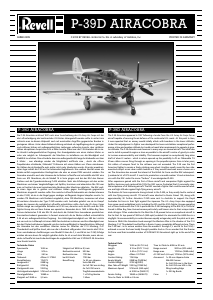

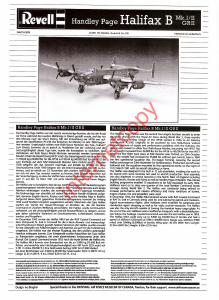
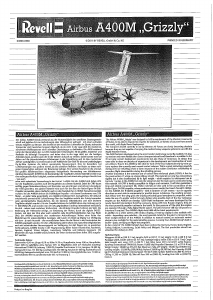
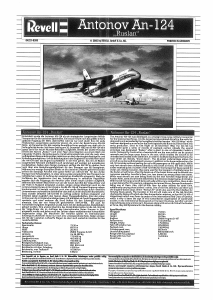
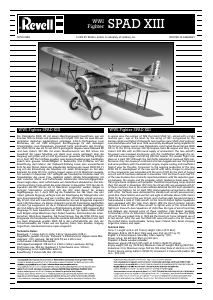
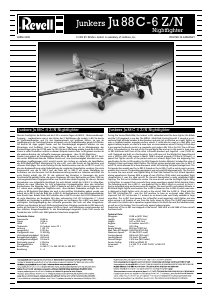
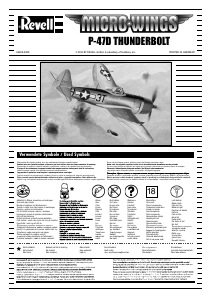
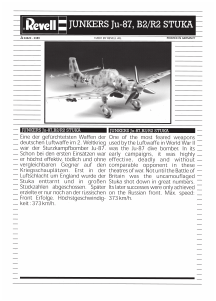

Partecipa alla conversazione su questo prodotto
Qui puoi condividere cosa pensi di Revell set 04868 Airplanes P-39D Airacobra. Se hai una domanda, leggi prima attentamente il manuale. La richiesta di un manuale può essere effettuata utilizzando il nostro modulo di contatto.